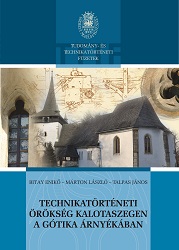Technikatörténeti örökség Kalotaszegen a gótika árnyékában
Gothic in Călata. A Legacy in the History of Technology
Author(s): Enikő Bitay, László Márton, János Talpas
Subject(s): History, Fine Arts / Performing Arts, Architecture, Essay|Book Review |Scientific Life, Local History / Microhistory, Scientific Life
ISSN: 2068-3103
Published by: Erdélyi Múzeum-Egyesület
Keywords: technical history; local history; Transylvania; bells; horologe; church architecture; gothic art
Summary/Abstract: Călata, an area with particular history and folklore, generated a specific, unmistakable architectural style, used especially in the construction of churches. Combining in harmony the Transylvanian tradition of the style and techniques used in the construction of the fortified Saxon churches, those of the Orthodox churches made of wood and of folk architecture in the area, the Călata style refers to churches with slim towers and shingle roofs. Most of these religious buildings, characterized by a perfect harmony of their proportions, most of them built in the Romanesque style and located on the most visible sites of the settlements, represent, even today, the attachment of the inhabitants to spiritual continuity and their homeland in the area of Călata.Five churches, built during the thirteenth and fourteenth centuries, stand out among the complex of such buildings in Călata through the fact that they share a series of architectural elements typical for the late Gothic style, with elements characteristic for the Transylvanian Gothic, with roots leading towards a beginning called the Cârþa Context. It was a puritan Gothic style created in the thirteenth century at the foot of the Southern Carpathians, in the settlement of Cârþa, in Sibiu County. The first Gothic church was built there. The style had been brought by the Cistercian monks in their expansion towards Eastern Europe. The first churches in the south and center of Transylvania were built following the style and building technique employed in the erection of the monastic architectural complex in Cârþa. Prejmer, Hărman, Braºov, Bistriþa and Cluj were the settlements adopting these rules in the building of their own churches.Abandoning the specificities of the Romanesque style, with its robust semicircular arcades, and employing a well-known, traditional building technology, people promoted the newdaring style,with tallwindows, full of light, ending in ogees, decorated with sculpted stone rails. It had ogee-shaped inner vaults, supported by profiled ribs ending in sculpted stone corbels embedded in the church walls and rows of slender pillars.The new style reached Călata later, towards the middle of the fifteenth century.Elements of this style were used in some churches, adapted to the architectural con ditions and dimensions of the existing churches in the area. Five such buildings were extended according to the Gothic architectural style, namely those in Huedin, Mănăstireni, Văleni, Căpuºu Mic, and Dorolþu.The first part of the present book consists of a comparative analysis of these five churches, focusing on the presence of Gothic elements and their preponderance in the complex of the respective edifices. The windows, gates, consolidations with buttresses, ogee vaults, and other stylistic elements are compared, aiming at determining, as much as possible, the motivation of those who promoted the new architectural style in this region.The second part of the book continues the research, from the point of view of the history of technology, with the other three Gothic churches, the ones in Văleni and Mănăstireni being presented in detail in two individual volumes recently published. Archive research and investigations have been performed, but on site measurements predominate. The construction, employed techniques, and stylistic elementsof the three churches, in Huedin, Căpuºu Mic, and Dorolþu were the aim of repeated field trips, measurements, and analyses.The bells in the towers of these three churches are another topic of interest in the present research. The history of these bells and of those preceding them, the circumstances leading to the disappearance of some medieval bells from these towers offer, not only to the authors but also to the reader, a true foray in the past of a craft considered up to the present day a top profession.The nineteenth century clocks placed in three of the five churches under discussion, have been, at the time they were bought, peak accomplishments of technology. The fact that these settlements managed to own clocks indicates that there was a social demand for their installation and there were significant financial resources at hand. The research includes the analysis of the kinematical scheme of these clock mechanisms and a comparison of their stylistic, technical, and technological elements in order to establish their origin.Three churches are thus analyzed in more detail in the present book, but the Gothic elements of the churches in Mănăstireni and Văleni are also presented succinctly for those readers who do not possess the first two volumes of the series which detail the history of technology researches related to the above mentioned settlements.The present volume ends a series of researches in the region of Călata. The three volumes related to the history of technology can be considered as opening new lines of research in the field and for other geographical areas.
- Print-ISBN-13: 978-606-8178-22-6
- Page Count: 100
- Publication Year: 2011
- Language: Hungarian
- Table of Content
- eBook-PDF
- Introduction

